Colne and Trawden Light Railways
(Colne Corporation Light Railways)
History
The Colne and Trawden Light Railway Company, which was owned by Batley and Greenwood Limited of Leeds, opened for business on the 28th November 1903. The gauge chosen was 4ft 0ins, to facilitate inter-running with the Nelson and Burnley Corporation systems to the southwest.
At its maximum extent, which it reached in 1905, the system totalled 5.23 miles, comprising lines: southwestward to the Nelson boundary; eastwards to Laneshawbridge; and southwards to Trawden. The C&TLR tracks met those of Nelson Corporation at the borough boundary, and from 1911 through-running was instigated, C&TLRCo tramcars running through to Nelson, and NCT tramcars running through to Colne. Burnley Corporation Tramways cars did occasionally work through to Colne on special workings, but never on regular services.
Although the C&TLRCo was the owner of the tramway, it did not operate the services itself, these being run by the builder and parent company, Batley and Greenwood. The tramway was hardly a money spinner, and this, coupled with the fact that tramway operation was not part of Greenwood and Batley's core business, eventually led to a decision to sell the undertaking, though they doubtless also had one eye on the future, when expensive renewals would be required. After first approaching Nelson Corporation, the concern was eventually sold to Colne Corporation (including the tracks within the Trawden Urban District Council's boundy) on the 25th March 1914.
Like many tramway systems, Colne's emerged from the rigours of the Great War in run-down condition with a significant backlog of repairs and renewals. Despite high costs and inflationary pressures, in 1919 the corporation chose to invest in new tramcars and track renewals, the last of the new tramcars arriving as late as 1926. Bus services were introduced in January 1923, no doubt helping to alleviate the worst effects of unregulated bus competition, though a significant trade slump in the cotton industry in the 1920s saw what little profits the tramway system made being used for other municipal purposes.
Stringent economy measures were implemented in the mid 1920s, including one-man operation, and on the 19th October 1926, the first tramway closure took place (the Laneshawbridge line). By 1927, the corporation had decided to abandon the tramway — despite having renewed the entire fleet and a good deal of the infrastructure — the line to Trawden succumbing on the 3rd June 1928. All that remained was the line to Nelson, which was allowed to deteriorate significantly over the next few years. In October 1932, the name of the department (as well as the committee which oversaw it) was changed to 'Colne Corporation Transport' to reflect the evolving service provision.
By 1932, the corporations of Burnley, Colne and Nelson saw combined municipal operation as the way forward, something that they perhaps ought to have considered in 1901/2. On the 1st April 1933, Colne's transport interests (including the trams) were transferred — together with those of Nelson and Burnley — to the Burnley, Colne and Nelson Joint Transport Committee. Burnley were of course the major player in the BC&NJTC, and its views tended to be transposed onto the enterprise as a whole. Whilst Colne Corporation had already abandoned a significant portion of its system, Nelson Corporation were very much against abandonment, having replaced their entire tramway fleet barely 13 years beforehand. The majority view nevertheless prevailed, Nelson being out-voted, so tram replacement proceeded across the entire concern, Colne included. The last tram service over former Colne Corporation tracks ran on the 6th January 1934.
Uniforms
Unfortunately, photographs depicting staff of the C&TLRCo or its municipal successor, CCLR, are fairly scarce, so there is precious little evidence to go on when relating the uniform story.
Early shots indicate that staff wore single-breasted jackets with stand-up collars, and though the latter probably bore badges of some kind, it is currently unclear what form these took. Caps were of the drooping-peak type, and appear to have borne script-lettering grade badges, though once again the paucity and poor quality of surviving images does not allow this to be discerned with absolute certainty. At some point, however, probably in the mid-Edwardian era, caps were changed to a tensioned-crown peaked style, and these certainly bore standard, off-the-shelf, script-lettering grade badges — 'Conductor' and 'Driver' — presumably in brass to match the buttons (see link), though even this cannot be stated with certainty!
Staff were also issued with double-breasted greatcoats with five pairs of buttons and high, fold-over collars; it is unclear whether the latter bore any insignia.
I have yet to see a single photograph from the corporation era showing a member of the tramways staff, so it is impossible to state what uniforms were worn from 1915 up until the absorption of the system into the Burnley, Colne and Nelson Joint Transport Committee in 1933.
With respect to senior staff, a single photograph taken prior to municipalisation appears to shows an inspector wearing an overcoat similar to those worn by tramcar crews; he is also wearing a cap with what appears to be a script-lettering cap badge, presumably 'Inspector'.
In common with many tramway systems, it is highly likely that Colne employed female staff during the Great War to replace male staff lost to the armed services; however, photographs are yet come to light, so it is impossible to say what uniforms were worn.
Further reading
For a history of Colne's tramway system, see: 'The Light Railways of Colne' by J S King, in Tramway Review, Nos 72 (p227-233 and 239-246), 73 (p259-274) and 74 (p50-62); Light Railway Transport League (1972 and 1973).
Images
Motormen and conductors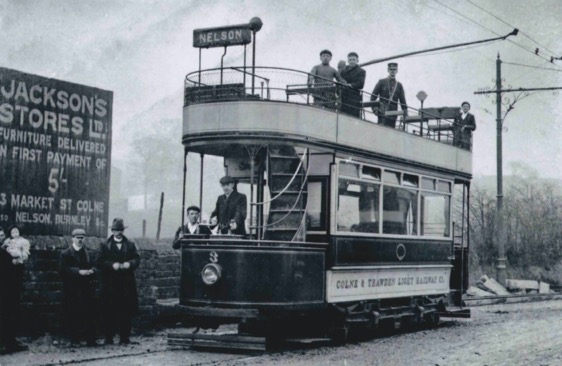
Tramcar No 3 stands outside what may be the depot on Heifer Lane in Colne — photo undated, but from the immaculate condition of the tram, probably taken shortly after its delivery in 1903. Author's Collection.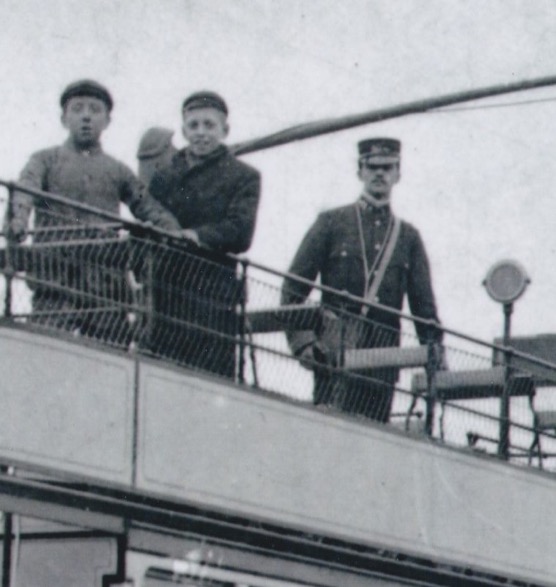
An enlargement of the above photograph showing the conductor. He is wearing a single-breasted jacket with stand-up collars and a drooping-peak cap bearing a script-lettering grade badge, almost certainly 'Conductor'.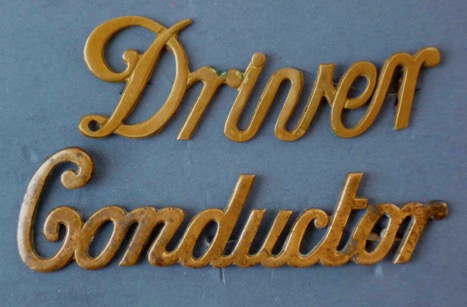
General pattern brass script-lettering cap badges of the type probably worn on tramcar crew caps. Author's Collection.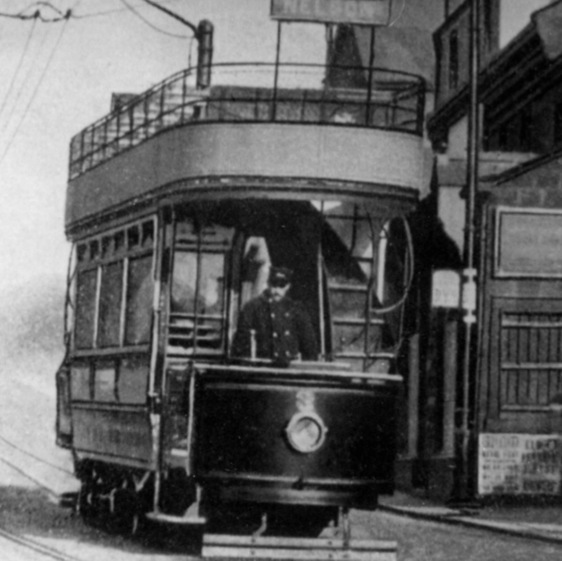
A motorman at the controls of Tramcar No 3 bound for Nelson — photo undated, but probably early Edwardian. Photo courtesy of the Tramways and Light Railway Society.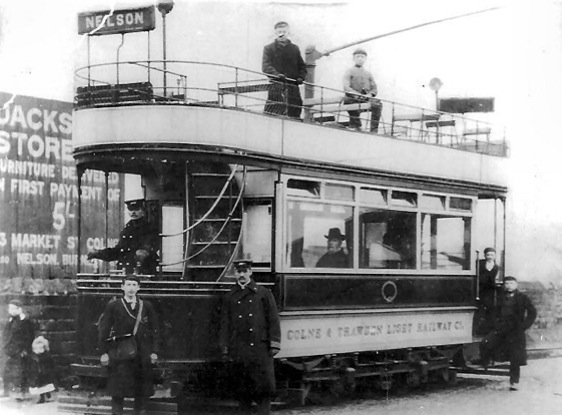
A motorman and a conductor (seemingly in informal attire) pose with Tramcar No 4, along with an individual who may be an inspector — photo undated, but probably mid Edwardian. By this time, a switch had clearly been made to tensioned-crown peaked caps. With thanks to Jim Halsall. 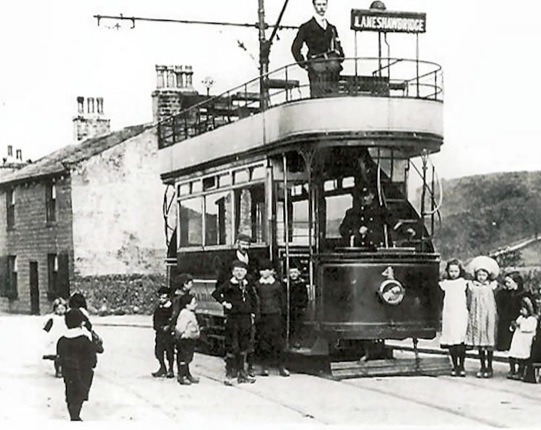
A motorman and a conductor, once again in informal attire, with Tramcar No 4 at the Emmott Lane Terminus at Laneshawbridge — photo undated, but certainly mid Edwardian. With thanks to Duncan Holden.